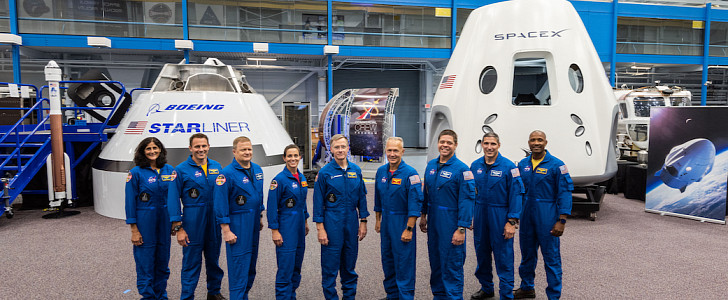On Friday, the world learned the names of the men and women that will be risking their lives in the coming year to prove that private companies can build, launch and land manned space capsules.
NASA announced the nine names of the astronauts that will get in the Crew Dragon and Starliner capsules for both the test flights and actual first missions. In between them, the astronauts have decades of space experience, including as members of the now-retired space shuttle.
For SpaceX's test flight, NASA assigned Robert Behnken and Douglas Hurley, both members of several Endeavour and Atlantis missions. The company's first mission, should the test be successful, will be flown by Victor Glover, at his first flight to space, and ISS veteran Michael Hopkins.
Boeing's capsule will be manned during the test flight by Eric Boe and Christopher Ferguson, both shuttle missions veterans, and Nicole Aunapu Mann, at her first flight to space. The first mission has been tasked to Josh Cassada (first time in space) and Sunita Williams, ISS astronaut.
“The men and women we assign to these first flights are at the forefront of this exciting new time for human spaceflight,” said in a statement Mark Geyer, director of NASA’s Johnson Space Center in Houston.
“It will be thrilling to see our astronauts lift off from American soil, and we can’t wait to see them aboard the International Space Station.”
For SpaceX’s Crew Dragon, the uncrewed mission has been designated Demo-1, and it will take off with the help of a Falcon 9 rocket from Complex 39A at NASA’s Kennedy Space Center in Florida.
Boeing Starliner’s flight will be known as the Orbital Flight Test, and it will depart atop a United Launch Alliance Atlas V rocket from Space Launch Complex 41 on Cape Canaveral Air Force Station in Florida.
For the missions to be successful, both capsules will have to launch, travel safely to the International Space Station (ISS), dock and undock autonomously and then safely bring the crews back to Earth.
Full details about the crews can be found in the document attached below.
For SpaceX's test flight, NASA assigned Robert Behnken and Douglas Hurley, both members of several Endeavour and Atlantis missions. The company's first mission, should the test be successful, will be flown by Victor Glover, at his first flight to space, and ISS veteran Michael Hopkins.
Boeing's capsule will be manned during the test flight by Eric Boe and Christopher Ferguson, both shuttle missions veterans, and Nicole Aunapu Mann, at her first flight to space. The first mission has been tasked to Josh Cassada (first time in space) and Sunita Williams, ISS astronaut.
“The men and women we assign to these first flights are at the forefront of this exciting new time for human spaceflight,” said in a statement Mark Geyer, director of NASA’s Johnson Space Center in Houston.
“It will be thrilling to see our astronauts lift off from American soil, and we can’t wait to see them aboard the International Space Station.”
For SpaceX’s Crew Dragon, the uncrewed mission has been designated Demo-1, and it will take off with the help of a Falcon 9 rocket from Complex 39A at NASA’s Kennedy Space Center in Florida.
Boeing Starliner’s flight will be known as the Orbital Flight Test, and it will depart atop a United Launch Alliance Atlas V rocket from Space Launch Complex 41 on Cape Canaveral Air Force Station in Florida.
For the missions to be successful, both capsules will have to launch, travel safely to the International Space Station (ISS), dock and undock autonomously and then safely bring the crews back to Earth.
Full details about the crews can be found in the document attached below.

